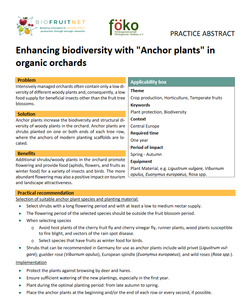{Tool} Enhancing biodiversity with "Anchor plants" in organic orchards (BIOFRUITNET Practice Abstract). Creator(s): Adolphi, Christina and Oeser, Niklas. Issuing Organisation(s): FÖKO - Fördergemeinschaft Ökologischer Obstbau. Biofruitnet Practice Abstract, no. 035. (2022)
|
PDF
- Published Version
- English
(Enhancing biodiversity with "Anchor plants" in organic orchards)
609kB | |
|
PDF
- Published Version
- German/Deutsch
(Förderung der biologischen Vielfalt mit "Ankerpflanzen" im Öko-Obstbau)
589kB | |
|
PDF
- Published Version
- French/Francais
(Améliorer la biodiversité grâce aux "plantes de tournière" dans les vergers biologiques)
611kB | |
![[thumbnail of 2024-09-16 17_10_19-Enhancing biodiversity with _Anchor plants_ in organic orchards - 35_Anchor_Plan.png]](/44718/7.hassmallThumbnailVersion/2024-09-16%2017_10_19-Enhancing%20biodiversity%20with%20_Anchor%20plants_%20in%20organic%20orchards%20-%2035_Anchor_Plan.png)  Preview |
Image (PNG)
- Cover Image
- English
96kB |
Document available online at: https://orgprints.org/44718
Summary in the original language of the document
Additional shrubs/woody plants in the orchard promote flowering and provide food (aphids, flowers, and fruits as winter food) for a variety of insects and birds. The more abundant flowering may also a positive impact on tourism and landscape attractiveness.
Practical recommendation
Selection of suitable anchor plant species and planting material:
• Select shrubs with a long flowering period and with at least a low to medium nectar supply.
• The flowering period of the selected species should be outside the fruit blossom period.
• When selecting species
o Avoid host plants of the cherry fruit fly and cherry vinegar fly, runner plants, wood plants suscepti-ble to fire blight, and vectors of the rain spot disease.
o Select species that have fruits as winter food for birds.
• Shrubs that can be recommended in Germany for use as anchor plants include wild privet (Ligustrum vul-gare); guelder rose (Viburnum opulus), European spindle (Euonymus europaeus); and wild roses (Rosa spp.).
Implementation
• Protect the plants against browsing by deer and hares.
• Ensure sufficient watering of the new plantings, especially in the first year.
• Plant during the optimal planting period: from late autumn to spring.
• Place the anchor plants at the beginning and/or the end of each row or every second, if possible.
| EPrint Type: | Practice tool |
|---|---|
| What problem does the tool address?: | Intensively managed orchards often contain only a low diversity of different woody plants and, consequently, a low food supply for beneficial insects other than the fruit tree blossoms. |
| What solution does the tool offer?: | Anchor plants increase the biodiversity and structural diversity of woody plants in the orchard. Anchor plants are shrubs planted on one or both ends of each tree row, where the anchors of modern planting scaffolds are located. |
| Country: | Germany |
| Type of Practice Tool: | Practice abstracts |
| Keywords: | Plant protection, Biodiversity |
| Agrovoc keywords: | Language Value URI English plant protection http://aims.fao.org/aos/agrovoc/c_5978 English biodiversity http://aims.fao.org/aos/agrovoc/c_33949 |
| Subjects: | Environmental aspects > Biodiversity and ecosystem services Crop husbandry > Production systems > Fruit and berries Crop husbandry > Crop health, quality, protection |
| Research affiliation: | European Union > Horizon 2020 > Biofruitnet Germany > Fördergemeinschaft Ökologischer Obstbau - FÖKO European Union > Organic Farm Knowledge |
| Horizon Europe or H2020 Grant Agreement Number: | 862850 |
| Related Links: | https://organic-farmknowledge.org/tool/44718, https://biofruitnet.eu |
| Project ID: | ofk |
| Deposited By: | Basler, Andreas |
| ID Code: | 44718 |
| Deposited On: | 09 Dec 2022 16:40 |
| Last Modified: | 16 Sep 2024 15:10 |
| Document Language: | English, German/Deutsch, French/Francais |
| Status: | Published |
Repository Staff Only: item control page

 Download Statistics
Download Statistics Download Statistics
Download Statistics
